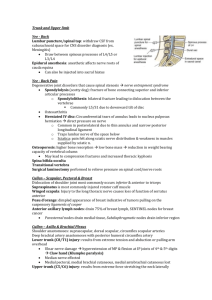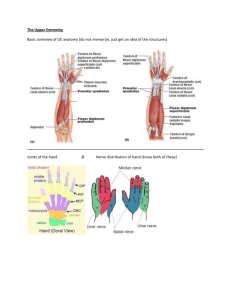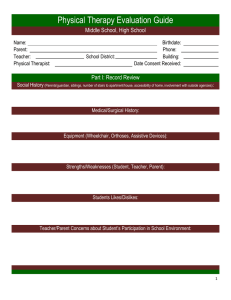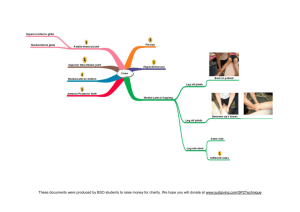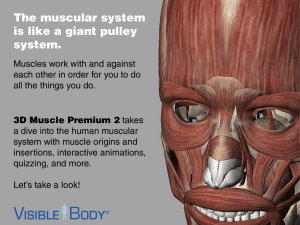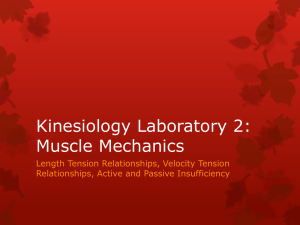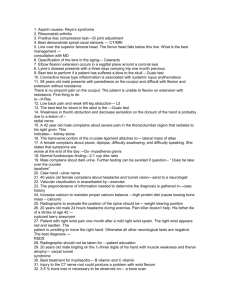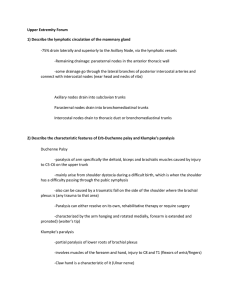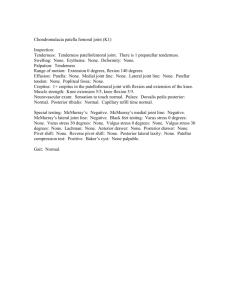Neck and Upper Extremity Exam Form
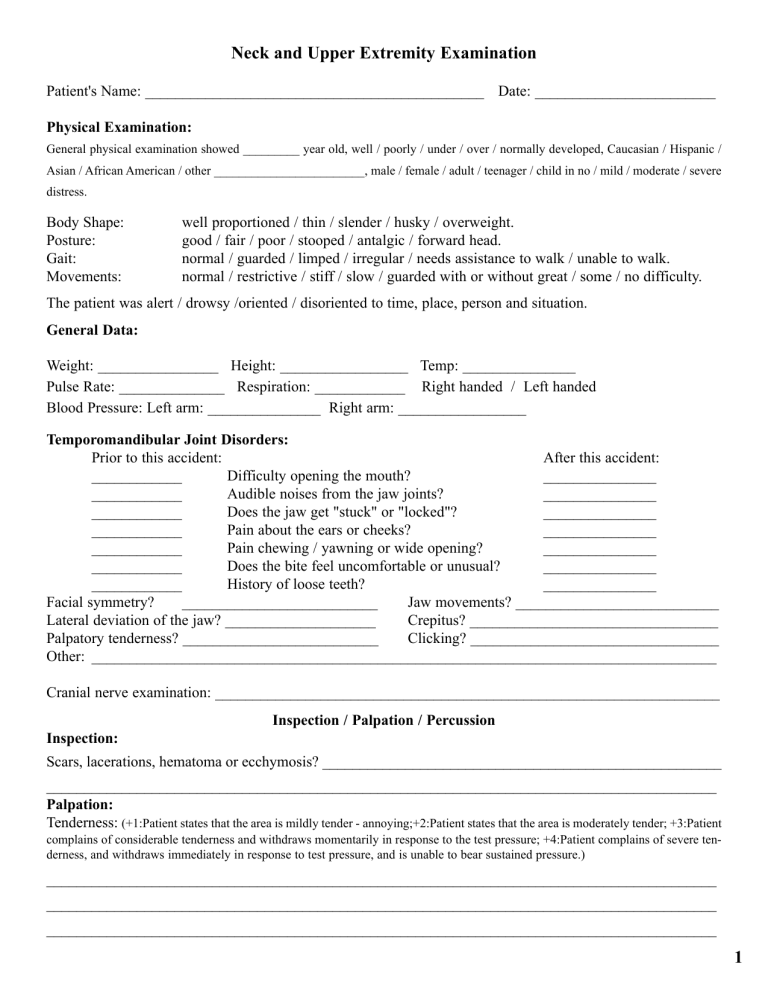
Neck and Upper Extremity Examination
Patient's Name: _____________________________________________ Date: ________________________
Physical Examination:
General physical examination showed _________ year old, well / poorly / under / over / normally developed, Caucasian / Hispanic /
Asian / African American / other ________________________, male / female / adult / teenager / child in no / mild / moderate / severe distress.
Body Shape:
Posture:
Gait:
Movements: well proportioned / thin / slender / husky / overweight.
good / fair / poor / stooped / antalgic / forward head.
normal / guarded / limped / irregular / needs assistance to walk / unable to walk.
normal / restrictive / stiff / slow / guarded with or without great / some / no difficulty.
The patient was alert / drowsy /oriented / disoriented to time, place, person and situation.
General Data:
Weight: ________________ Height: _________________ Temp: _______________
Pulse Rate: ______________ Respiration: ____________ Right handed / Left handed
Blood Pressure: Left arm: _______________ Right arm: _________________
Temporomandibular Joint Disorders:
Prior to this accident:
____________
____________
____________
Difficulty opening the mouth?
Audible noises from the jaw joints?
Does the jaw get "stuck" or "locked"?
After this accident:
_______________
_______________
_______________
____________
____________
____________
____________
Pain about the ears or cheeks?
Pain chewing / yawning or wide opening?
Does the bite feel uncomfortable or unusual?
History of loose teeth?
Facial symmetry?
__________________________
_______________
_______________
_______________
_______________
Jaw movements? ___________________________
Lateral deviation of the jaw? ____________________ Crepitus? _________________________________
Palpatory tenderness? __________________________ Clicking? _________________________________
Other: ___________________________________________________________________________________
Cranial nerve examination: ___________________________________________________________________
Inspection / Palpation / Percussion
Inspection:
Scars, lacerations, hematoma or ecchymosis? _____________________________________________________
_________________________________________________________________________________________
Palpation:
Tenderness: (+1:Patient states that the area is mildly tender - annoying;+2:Patient states that the area is moderately tender; +3:Patient complains of considerable tenderness and withdraws momentarily in response to the test pressure; +4:Patient complains of severe tenderness, and withdraws immediately in response to test pressure, and is unable to bear sustained pressure.)
_________________________________________________________________________________________
_________________________________________________________________________________________
_________________________________________________________________________________________
1
Patient's Name: _________________________________________ Date: ________________________
Muscle Tone:
(Normal:0; +1:Sustained muscle contraction with mild resistance to passive motion in any direction; +2:Sustained muscle contractions with moderate resistance to passive motion in any direction with some restriction in motion; +3:Muscle rigidity with complete resistance to passive motion in some direction; +4: Spasm triggered by/with movement or external irritation, e.g., probing on movement triggers a muscle contraction; +5: Exists in/with absence of movement or external irritation, e.g., muscle contracture; observable and often causes antalgic posture or listing.)
_________________________________________________________________________________________
_________________________________________________________________________________________
Trigger/Myofascial Points: (Active, Latent, Satellite and location)
_________________________________________________________________________________________
_________________________________________________________________________________________
Vertebral percussion of the spine: ____________________________________________________________
Cervical Ranges of Motions: (with location of pain)
Flexion (0-45)
Extension (0-45)
Active/Passive
ROM
Active/Passive
Pain
Range _______/_______ _______/_______ pain w/resist _______
Range _______/_______ _______/_______ pain w/resist _______
R. Lateral Flexion (0-45) Range _______/_______ _______/_______ pain w/resist _______
L. Lateral Flexion (0-45) Range _______/_______ _______/_______ pain w/resist _______
R. Rotation (0-80)
L. Rotation (0-80)
Range _______/_______
Range _______/_______
_______/_______
_______/_______ pain w/resist _______ pain w/resist _______
Upper Extremity – Range of Motion / Muscle Strength
Active ROM
Left Right
Shoulder:
Flexion (C5) (0-170)
Extension (C5) (0-30)
Abduction (C5) (0-170)
_______ _______
Passive ROM
Left Right
_______ _______
Strength
Left Right
_______ _______
_______ _______ _______ _______ _______ _______
_______ _______ _______ _______ _______ _______
Adduction (C6, C7)
Int. Rotation (C5) (0-60)
_______ _______ _______ _______ _______ _______
_______ _______ _______ _______ _______ _______
Ext. Rotation (C5) (0-80) _______ _______ _______ _______ _______ _______
Shoulder Shrug (CN XI) _______ _______ _______ _______ _______ _______
Elbow:
Flexion (C5, C6) (0-135) _______ _______ _______ _______ _______ _______
Extension (C6, C7) (0-180) _______ _______ _______ _______ _______ _______
Forearm:
Pronation (0-75)
Supination (0-85)
_______ _______ _______ _______ _______ _______
_______ _______ _______ _______ _______ _______
Wrist:
Flexion (C7) (0-70)
Extension (C6) (0-65)
Ulnar Dev. (0-40)
Radial Dev. (0-20)
MCP Joints:
Flexion (C8)
Extension (C6)
Abduction (T1)
Adduction (T1)
Fingers:
Flexion (C8)
Extension (C7)
_______ _______
_______ _______ _______ _______ _______ _______
_______ _______ _______ _______ _______ _______
_______ _______
_______ _______
_______ _______
_______ _______
_______ _______
_______ _______
_______ _______
_______ _______
_______ _______
_______ _______
_______ _______
_______ _______
_______ _______
_______ _______
_______ _______
_______ _______
_______ _______
_______ _______
_______ _______
_______ _______
_______ _______
_______ _______
_______ _______
2
Patient's Name: _________________________________________ Date: ________________________
Grip Strength / Hand Dynometer
Right
The patient is right / left handed.
__________ / _________ / __________ PSI
Left __________ / _________ / __________ PSI
Sensation: (dermatomes)
Touch_____________________________________________________________________________
Pinprick _________________________________________________________________________
Temperature _______________________________________________________________________
Vibration _________________________________________________________________________
Light Touch _______________________________________________________________________
Reflexes
Biceps
(0:No response; 1+:Hyporeflexia; 2+: Normal; 3+: Hyperreflexia; 4+: Hyperreflexia with transient clonus;
5+: Hyperreflexia with intermittent or sustained clonus)
Right _________ Left __________
Triceps
Brachioradialis
Right _________
Right _________
Left __________
Left __________
Coordination: Finger to nose _________________________
Muscle Atrophy / Girth:
Upper arm
Forearm
Hand
R _________ L ___________ Distance from olecranon ______________in/cm
R _________ L ___________ Distance from lateral epicondyle _________in/cm
Hypothenar Right _________
Thenar
Intrinsics
Right _________
Right _________
Left __________
Left __________
Left __________
Orthopedic / Neurological:
Horner's Syndrome: ______________ Orthostatic Hypotension: _________________________
Cervical
Spurling's Test: ____________________________ Neck Traction Test: ______________________
Maximum Foraminal Compression Test: ________________ DeKleyn's Test: __________________
Bruit in Brachial Plexus Area: Right _________ Left ___________
Compression of Brachial Plexus Reproduces Symptoms: Right _________ Left ___________
Shoulder
Impingement Sign: Right ______ Left ________ Duga’s Test: Right ______ Left ________
Adson's Test: Right ______ Left ________ Wright's Test: Right __________ Left ____________
Codman’s Test Drop arm test for rotator cuff tear: Right ______ Left ________
Apprehension Test: Right ______ Left ________ Appley’s Test: Right ______ Left ________
Yergason's Test: Right ______ Left ________ Rotator Cuff Tendonitis: Right ______ Left ________
Subdeltoid Crepitus: Right ______ Left ______
Shoulder Compression Test: Right ______ Left ________
3
Patient's Name: _________________________________________ Date: ________________________
Elbow
Tinel's Sign: (ulnar nerve at elbow) Right _________ Left ___________
Instability Test: Right _______ Left _________
Cozen’s Test: Right _______ Left _________
Golfer’s Elbow : Right _______ Left _________
Epicondyle palpation: Medial Right _________
Lateral Right _________
Left ___________
Left ___________
Hand/Wrist
Finkelstein's Test: Right _________Left ___________
Allen's Test : Right ________ Left __________
Tinel's Sign: (ulnar nerve at wrist) Right _________
Phalen's Test: Right _________ Left ___________
Left ___________
Root Disc Muscles Reflex Sensation
C5 C4-C5
C6
C7
C8
T1
C5-C6
C6-C7
C7-T1
T1-T2
Deltoid
Biceps
Biceps Lateral arm
Axillary nerve
Biceps
Wrist extensors
Triceps
Wrist flexors
Finger extensors
Hand intrinsics
Finger flexors
Brachioradialis
Triceps
Hand intrinsics
Lateral forearm
Musculocutaneous nerve
Middle finger
Medial forearm
Medial antibrachial branch of the cutaneous nerve
Medial arm
Medial brachial cutaneous nerve
